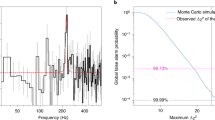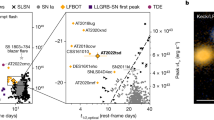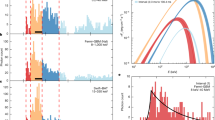Abstract
Among X-ray transients, A0538–66 is unique: between June and December 1977 it was observed to undergo seven out-bursts1–3 , characterized by different durations (from ∼12 h to ∼15 days) and peak intensities (from ∼0.03 to 0.1 Crab). Most remarkably, the outbursts were all separated by an interval of either 16.7 days or a small multiple thereof. The source may be a member of the Large Magellanic Cloud (LMC) and thus one of the most luminous stellar X-ray sources known [(Lx (2–17 keV)≃8×1038 erg s−1)]. No steady counterpart to the flaring source has yet been detected. We report here a reanalysis of the HEAO 1 modulation collimator (MC) data which has led to the detection of the five outbursts which occurred between August and December 1977. A uniquely precise (25 arc s) position has been obtained which excludes the previously suggested optical candidate. We have searched archive plates of the LMC and find that one of the stars in the refined error region shows variability in the B band by ∼1 mag.
This is a preview of subscription content, access via your institution
Access options
Subscribe to this journal
Receive 51 print issues and online access
$199.00 per year
only $3.90 per issue
Buy this article
- Purchase on Springer Link
- Instant access to full article PDF
Prices may be subject to local taxes which are calculated during checkout
Similar content being viewed by others
References
White, N. E. & Carpenter, G. F. Mon. Nat. R. astr. Soc. 183, 11P (1978).
Johnston, M. et al. Astrophys. J. Lett. 230, L11 (1979).
Skinner, G. et al. Astrophys. J. (submitted).
Johnston, M., Bradt, H. & Doxsey, R. Astrophys. J. 233, 514 (1979).
Gursky, H. et al. Astrophys. J. 223, 973 (1978).
Johnston, M. thesis MIT (1978).
Avni, Y. Astr. Astrophys. 66, 307 (1978).
Dachs, J. Astr. Astrophys. 223, 730 (1972).
Johnson, H. Astrophys. J. 223, 282 (1978).
Crampton, Astrophys. J. (in the press).
Lewin, W. H. G. in X-ray Astronomy (eds Baity, W. A. & Peterson, L. E.) 133, (Pergamon, Oxford, 1979).
Cominsky, L., Jones, C., Forman, W. & Tananbaum, H. Astrophys. J. 224, 46 (1978).
Rappaport, S. et al. Astrophys. J. Lett 206, L139 (1976).
Cooke, B. A. Nature 261, 564 (1976).
Ricketts, M. J., Cooke, B. A. & Pye, J. P. Bull. Am. astr. Soc. 10, 516 (1978).
Schrijver, J. et al. Astr. Astrophys. 69, L1 (1978).
Griffiths, R. E. et al. in X-ray Astronomy (eds Baity, W. A. & Peterson, L. E.) 93, (Pergamon, Oxford, 1979).
Author information
Authors and Affiliations
Rights and permissions
About this article
Cite this article
Johnston, M., Griffiths, R. & Ward, M. Improved position and new optical candidate for A0538–66. Nature 285, 26–27 (1980). https://doi.org/10.1038/285026a0
Received:
Accepted:
Issue Date:
DOI: https://doi.org/10.1038/285026a0
This article is cited by
-
X-ray emission from Be star/X-ray binaries
Space Science Reviews (1994)
-
The very soft X-ray transient H1853 + 60
Nature (1981)
-
An optical outburst from the periodic recurrent X-ray transient A0538-66
Space Science Reviews (1981)
Comments
By submitting a comment you agree to abide by our Terms and Community Guidelines. If you find something abusive or that does not comply with our terms or guidelines please flag it as inappropriate.



